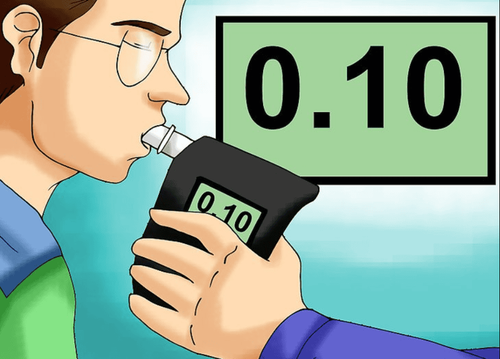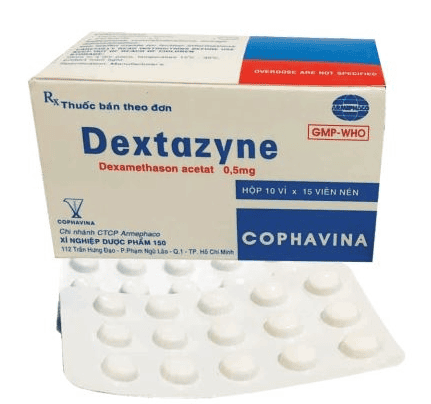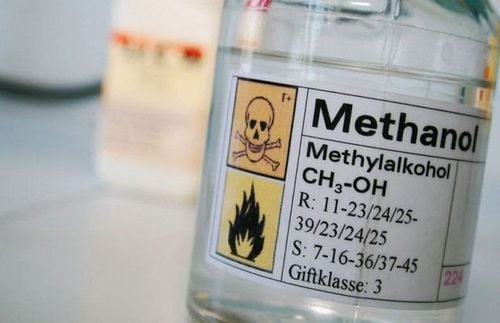This is an automatically translated article.
Article written by MSc Vu Hoang Huy - Emergency Doctor, Emergency Department - Vinmec Times City International Hospital
Methanol, also known as wood alcohol, is an organic solvent that is commonly used in products such as automotive glass spray solution, cleaning agent, fuel for furnaces,... Methanol poisoning is still prevalent. is a common problem in many parts of the developing world, especially among members of the lower socioeconomic classes. Treatment of acute methanol poisoning needs to be conducted early, with the right method to save the patient's life and limit complications.
1. Learn about Methanol
1.1. Introduction to methanol
Methanol, also known as methyl alcohol with the chemical formula CH4O or CH3OH, was accidentally discovered by the ancient Greeks when hydrolysing wood, but the methanol product at that time existed in the form of impurities, mixed with other substances. . Pure methanol was first synthesized by Robert Boyle in 1661 by hydrolysis of boxwood. To date, methanol is produced industrially by chemical reaction with commonly used substrates, carbon monocid (CO), carbon dioxide (CO2) and hydrogen gas (H2). Methanol is a colorless solution, which evaporates at room temperature, with a molecular weight of 32dalton, a boiling point of 64.7°C, a specific gravity of 0.8115.
In nature, there are some bacteria that produce methanol through anaerobic metabolism, but then the methanol reacts with oxygen to convert it to CO2 and water. Therefore, the amount of methanol produced by the fermentation reaction of natural bacteria is negligible.
Methanol has some physical properties quite similar to ethanol, is a colorless, volatile liquid with a slight odor and taste similar to ethanol, but is very toxic and is not intended for use as a beverage.
1.2. Toxicology
Absorption
Methanol is rapidly absorbed after oral administration, with an average absorption time of 5 minutes depending on the presence of food or not, peak concentrations reached after 30-60 minutes. Methanol is relatively well absorbed through the skin. Methanol is well absorbed from the respiratory tract because it is water soluble and partially adsorbed by respiratory mucus, with an estimated pulmonary absorption of 65-75%20.
Distribution
Methanol is water soluble, volume of distribution is about 0.6-0.7 l/kg, unbound plasma proteins, mean half-life is 14-30 hours, if taken with ethanol this time is 43-96 hours.
1.3. Toxic dose
Most experts agree to start detoxification when the blood methanol level is above 20mg/dl because this is the starting concentration for visual impairment and metabolic acidosis. Drinking 30-100 ml of pure methanol causes death, a dose of less than 4 ml causes visual impairment and even blindness.
Author Bennet studied on 323 patients with methanol poisoning and found that the patient died with the lowest oral dose of about 15 ml of 40% methanol solution, but there were cases of survival when drinking 500 ml if it came early, the dose The generally accepted hazard is 30ml.
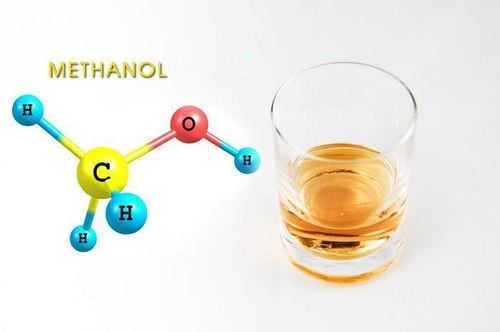
1.4. Metabolism in vivo and mechanism of toxicity of methanol
Metabolize methanol Methanol into the body through the gastrointestinal tract, inhalation, through the skin, or directly through the intravenous route, undergoing rapid absorption followed by all organs and tissues.
Metabolism of methanol mainly occurs in hepatocytes (97%), a small amount is eliminated in the pure form in the urine (1%) and exhaled air (2.5%). Metabolizing methanol in two stages.
Stage 1: Converting methanol to formaldehyde by three enzyme systems: acohol dehydrogenase (ADH), microsomal alcohol oxidizing system (MEOS) and catalase. Stage 2: Formaldehyde is formed, which is a toxin that is quickly converted to formic acid by the enzyme formaldehyde dehydrogenase (FDH).
1.5. Mechanism of toxicity of methanol
Formic acid causes metabolic acidosis
Methanol is converted to formaldehyde. Formadehyd exists very short in plasma (1-2 minutes), then very quickly converted to formic acid, formic acid is metabolized slowly, so it accumulates and causes toxicity.
Formic acid is weak acid, but still stronger than carbonic acid (H2CO3), so when born in the body, it will cause acidosis in the blood. In addition, the metabolism of methanol through the first two reactions requires NAD+ to produce NADH. NADH then participates in a chemical reaction and converts pyruvate into lactic acid, producing a product called lactic acid, which causes hyperlactatemia. The presence of lactic acid aggravates acidosis. Because the acidosis in methanol poisoning is caused by formic acid and lactic acid, it is classified as a metabolic acidosis with increased anion gap. About 50% of acidemia is caused directly by formic acid, the rest is caused by lactic acid. In addition, patients with ethanol poisoning have a small amount of ketones that contribute to acidosis.
There are several factors that affect formic acid metabolism. Under physiological pH conditions, formic acid is dissociated into formate and hydrogen ions. Then the format is converted to CO2 and H2O. However, the conversion of formate is multi-reactive and depends on vitamin B12 and S-adenosylmethionin (SAM) catalysis.
Formic acid inhibits cellular respiration
Formic acid, after being created, will follow the blood to penetrate the target tissue and then enter the cells. Formic acid binds to the 6th position of the iron molecule in the Heme nucleus of cytochrome oxidase molecules, especially cytochrome aa3, an enzyme that functions as a redox in the electron transport chain and inhibits enzyme activity. This prevents the redox reaction that interrupts cellular respiration in other words inhibits cellular respiration causing cytotoxicity.
When blood pH decreases, the more formic acid exists in the undissociated state, the more it is able to penetrate tissues and target organs such as the retina, cross the blood-brain barrier and enter mitochondria. The inner surface of the mitochondrial membrane allows only the undissociated form to move in, so that in acidosis, the inhibition of cellular respiration is favorable, the more acidic the blood, the stronger the inhibition will lead to injury. more cells.
Formic acid is toxic to the eyes
Early research suggests that the culprit for vision damage is formaldehyde. However, recent studies have shown the role of formic acid because formaldehyde only exists in plasma for a short time of 1-2 minutes. Ocular toxicity is not due to metabolic acidosis but to direct toxicity of formic acid on retinal neurons and optic discs. However, metabolic acidosis can increase toxicity by increasing the diffusion of formic acid into cells, so metabolic acidosis is a favorable factor and causes more prolonged damage.
Formic acid acts on the optic disc target and the posterior retinal position of the optic nerve causing nerve edema, destruction of the myelin layer and damage to the optic nerve.
Undissociated formic acid binds to cytochrome oxidase, inhibits mitochondrial function of the optic nerve and retina, and reduces ATP of the optic nerve and retina. Reducing ATP reduces the activity of the Na+-K+-ATPase pump on the optic nerve cell membrane, causing a loss of function of the mitochondria in the optic nerve cells that need ATP (maintaining the resting membrane potential) to do so. damage the myelin sheath and cause vision loss. When the myelin sheath is damaged, they begin to swell, causing damage to compress the nerve fibers. This prevents protein conduction in axons, mitochondria, and neural tubes from the nerve cell body to the axon. As cells lose function they become more sensitive to formic acid and cause damage that leads to loss of nerve conduction and loss of vision. Selective damage to the optic nerve and retina may result from increased formic acid exposure due to the abundant blood flow through the capillaries of the ophthalmic choroid and from the cerebrospinal fluid. This allows formic acid to diffuse to the optic nerve periphery.
Formic acid is toxic on the central nervous system
Studying magnetic resonance imaging or computed tomography of the brain, autopsies of patients with acute methanol poisoning, the authors found edema and necrotic lesions of the basal nuclei, characterized by dark duckweed nucleus, and subcortical white matter hemorrhage. The cause of cellular edema at these sites is that formic acid inhibits cytochrome activity in neuronal mitochondria leading to inhibition of Na+-K+-ATPase activity. Several hypotheses have been proposed to explain the specific lesion in the podoma:
The high concentration of formic acid in the sclerotia is due to decreased venous drainage in the pea nucleus from the vein of Rosenthal. Insufficient arterial perfusion. The consumption of oxygen and glucose is higher than that of other adjacent white matter regions or basal nuclei. The effects of hemodynamic changes such as arterial blood pressure and anemia can be localized.
2. Characteristics of patients with acute methanol poisoning
2.1. Clinical characteristics of patients with acute methanol poisoning
The clinical manifestation of acute methanol poisoning is multi-organ damage. In typical acute methanol poisoning patients, mild CNS depression symptoms first appear, within 30 minutes of ingestion. After that, there are usually 2 stages: the inconspicuous phase (about 12-24 hours, can be longer depending on the amount of methanol taken, whether taken with ethanol, vomiting or not as well as kidney function) and the toxic phase. evident with decompensated metabolic acidosis, visual disturbances, Kussmaul breathing due to metabolic acidosis, respiratory failure, shock.
Central nervous system symptoms
In acute methanol poisoning, some symptoms such as headache, dizziness, lethargy, confusion often occur with mild to severe severity. Methanol causes less excited states than ethanol. The occurrence of coma and convulsions in cases of severe poisoning is due to cerebral edema. Survivors with optic nerve sequelae may develop Parkinson-like manifestations and mild dementia later in life.
Eye symptoms
Diagnosis of optic neuropathy due to methanol poisoning:
Diagnosis of optic nerve damage when the following typical symptoms are present:
Disease using alcohol with methanol. No eye pain, bilateral bilateral vision loss or reduction. Ophthalmoscopy for lesions. Symptoms of optic nerve damage in acute methanol poisoning:
In acute methanol poisoning early symptoms of visual damage include photophobia, blurred vision, disturbances in color vision and light reflexes, lesions visual field and disc edema with a zigzag retinal vascular system. However, in some cases, there is only a transient loss of vision, vision returns to normal within the first few hours after being treated, if after 6 days, there is no improvement, vision often deteriorates.
The first symptom of visual acuity ranges from blurred vision, changes in field of vision to complete loss of vision. Many patients see the entire field of vision as a white or gray fog. Patients with severe vision loss can only count their fingers, in some cases not see light. Visual damage caused by formic acid is toxic to retinal cells and optic discs. Damage to the eye is aggravated by metabolic acidosis.
During the acute phase of poisoning, hyporeflexia occurs in all patients (with reduced visual acuity and normal vision). Reduced light reflection has prognostic value. Patients with dilated and fixed pupils often die, and if they live, they often have severe visual impairment. Cases of permanent vision loss all have damage to the response of the pupil to light.
Ophthalmoscopy shows different degrees of damage. Congestive optic disc when visual damage progresses, congestive lesions persist from day 1 to day 7. From 6 hours to 24 hours after congestion, progression of angioedema can be seen from the optic disc to the adjacent retina. Edema usually spreads along the major capillaries of the retina and lasts 10 to 60 days. Retinal venous stasis is often associated with retinal edema. Fundus changes were seen in 87% of patients with initial vision loss and in all patients with permanent visual impairment. Mild or moderate retinal edema has some cases of complete vision recovery, some cases of vision loss. Severe retinal edema causes permanent vision loss. In some cases, the visual acuity in both eyes is different, although the changes in ophthalmoscopy are the same on both sides. The shape of the opacities is often explained for differences in visual acuity. In the central visual field of the better eye, the macula spreads to the blind spot covering the macula of the eye. In the other eye, the opacity, including the macula and the blind spot, completely erased the important area of vision. After 4 to 6 months vision in the better eye starts to decrease and drops to the same level as in the other eye.
Respiratory and circulatory symptoms
Respiratory failure, Kussmaul breathing, weak breathing, respiratory arrest when the methanol has been metabolized causes metabolic acidosis.
Circulatory failure manifests at first, usually rapid pulse, low blood pressure. More severe can see bradycardia, hypotension unresponsive to vasopressors and circulatory arrest.
Gastrointestinal symptoms
Methanol poisoning causes nausea, vomiting and abdominal pain. Gastrointestinal bleeding may occur with vomiting blood, black stools.
Acute pancreatitis is a fairly common complication of methanol poisoning. Elevated liver enzymes are usually mild and transient. However, gastrointestinal manifestations do not reflect the severity of toxicity.
Renal symptoms
Acute rhabdomyolysis is a rare complication of methanol poisoning. However, it can cause acute kidney damage, which is a serious sign of methanol poisoning. Renal dysfunction is usually severe by day 8 of hospital stay and returns to normal within 1 month.
2.2. Subclinical characteristics of patients with acute methanol poisoning
Disorders of acid-base balance:
Patients after drinking alcohol show metabolic acidosis with increased anion and ALTT gaps while lactate is moderately increased, so methanol poisoning should be considered. This strategy is important because the quantification of methanol takes time, while aggressive management is required. However, it should be distinguished from some similar clinical conditions such as diabetic ketoacidosis, alcoholic ketoacidosis, and septic shock.
Anion Gap
Anion Gap is the difference between the total cations and the total anions measured. Under normal conditions, this gap represents negatively charged proteins, fatty acids, and inorganic anions (sulphates, phosphates). The normal anion gap is 12-16 mmol/l. Formic acid and lactic acid (to a lesser extent) contribute to the anion gap in acute methanol poisoning. When methanol is converted to formic acid, the anion gap increases markedly. Formic acid, after being formed, inhibits the cellular respiratory chain at the cytochromes to create lactic acid and further increases the anion gap. Formula to determine anion gap:
Anion gap (mmol/l) = (Na+ + K+) – (HCO3- + Cl-).
According to one study, most patients with severe methanol poisoning with plasma bicarbonate < 18 mmol/l had methanol concentrations above 50 mg/dl and formic acid occupied 42% of the anion gap.
The evolution of the ALTT gap and the anion gap can be visualized according to the diagram below
\
The osmotic gap
Blood osmotic pressure (ALTT) is the pressure caused by the partial concentrations of substances different solubility per unit of water in plasma.
Measure osmotic pressure (mosm/kgH2O) by machine: measure the freezing point of the solution (each 1 mosmol of any solute dissolved in 1 kg of water will reduce the freezing point of the solution to 1.86oC). Estimated osmolality (mosm/l) = 2 [Na] (mmol/l) + [glucose] (mmol/l) + [ure] (mmol/l). Gap ALTT = measured ALTT - estimated osmolality.
ALTT gap for quick evaluation of unmeasured ALTT generating components. Under physiological conditions, the ALTT gap is approximately 10, which is composed of calcium, anions, proteins, and lipids. Increase the ALTT gap when greater than 10-15.
Most drugs and toxins have not been identified to cause an increase in ALTT because even in poisoning the concentrations of the substances do not sufficiently affect the measured ALTT because of their high molecular weight. The most common poisoning that causes an increase in the ALTT gap is ethanol poisoning. In addition, there are some poisonings that cause increased ALTT such as methanol, ethyleneglycol, isopropanol, ethyl ether.
Increase in ALTT maximal when methanol absorption peaks, before metabolism occurs. According to the process of methanol metabolism, when the patient is newly admitted to the hospital due to the high amount of methanol in the blood, the ALTT gap will increase, later on, because the methanol is converted to formic acid, the ALTT gap will gradually decrease (methanol decreases, formic acid is not involved. increasing ALTT gap) and increasing anion gap (due to increased formic acid). Therefore, at a late stage, the ALTT gap does not reflect the severity of toxicity, and the absence of the ALTT gap does not rule out methanol poisoning.
Methanol concentration
Quantitative test of methanol in whole blood by gas chromatography. Concentration results can help confirm the diagnosis and predict the severity of poisoning. However, in cases of late onset after several days of complete metabolism of methanol or after first-line hemodialysis, the methanol test is often negative, so the late test result is often of little value. Thus, clinical symptoms and mortality prognosis are closely related to metabolic acidosis, formate concentration rather than plasma methanol concentration.
Imaging
The most common lesion in methanol poisoning is bilateral dark duckweed nuclei necrosis, if computed tomography is taken within the first 24 hours after methanol poisoning, usually no lesions appear. In cases of severe poisoning, deep coma, cranial tomography at the time of admission may show a decrease in the density of the dark duckweed and caudal nuclei. Bilateral dark duckweed necrosis is not specific for methanol poisoning. Some other conditions that cause fascia damage include Wilson's disease, familial neurodegenerative disorders, Leber's optic atrophy, Leigh's disease (Subacute necrotizing encephalomyelopathy), and ischemic/deficient lesions oxygen.
Although initial MRI does not show any abnormality of the optic nerve, even if the patient is clinically blind, after one month of MRI can show atrophy of the optic nerve and fibers Anterior optic nerve interferes with the optic nerve. Occipital cortical lesions present on MRI may suggest permanent visual disturbances. Other common CT and MRI findings in patients with methanol poisoning include cerebral edema and subcortical white matter lesions, particularly in the frontal, occipital, and parietal lobes. The peripheral components of the cerebellar white matter are usually not affected. Cerebral edema typical of methanol poisoning can cause compression of the ventricular system and brainstem herniation. Less common injuries associated with methanol poisoning include cerebellar necrosis and subarachnoid hemorrhage. Cerebral hemorrhage is a complication of methanol poisoning.
3. Diagnosis of acute methanol poisoning
3.1. Diagnosis towards methanol poisoning
Acute methanol poisoning should be considered when approaching emergency care for any patient with clinical signs suggestive of abnormalities in consciousness and vision:
Recent drinking, suspected methanol.
If it comes early, it may only manifest as vomiting, mild disturbance of consciousness, behavioral disturbance, mild visual disturbance, blurred vision. If it comes later, there may be coma, convulsions, labor, rapid deep breathing or pulmonary edema, hypotension, oliguria, anuria.
Blood gas tests show an increased anion gap metabolic acidosis and usually do not or respond poorly to conventional treatment such as intravenous fluids, bicarbonate infusion.
The osmotic gap (ALTT) and anion gap can help predict the severity of poisoning. However, the ALTT gap has some limitations:
Cannot distinguish whether ethanol or methanol has been consumed. There is low sensitivity in the setting of late arrival to the emergency room because most of the methanol has been metabolised. Not sensitive enough to rule out because severe poisoning has an ALTT gap not greater than 10. Patients who drink large amounts of ethanol (>100mg/dl) may have an elevated ALTT gap.
3.2. Differential diagnosis
Acute ethanol poisoning (increased ALTT, lactic acidosis, response to conventional therapy).
Medical condition with increased anion gap metabolic acidosis:
Diabetic ketoacidosis. Alcoholic ketoacidosis. Lactic acidosis (metformin poisoning, septic shock, acute pancreatitis...)
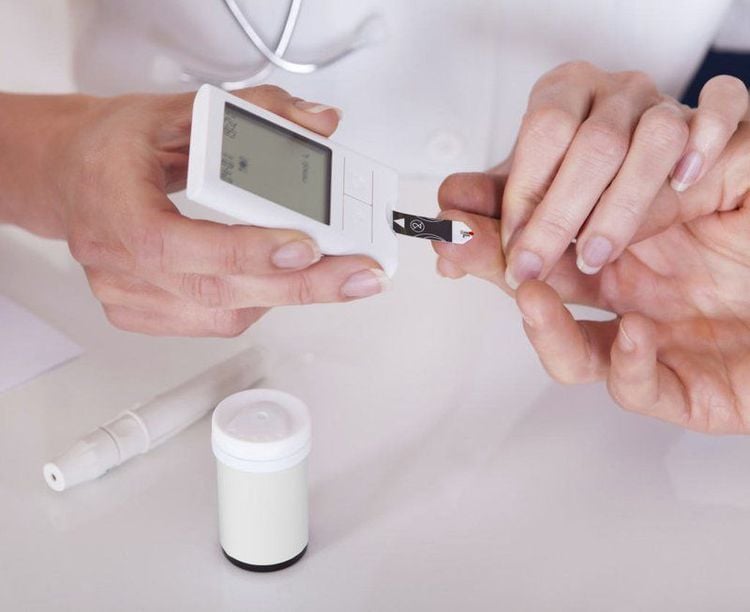
3.3. Implementing the quadrants
According to Zakharov et al., a patient is diagnosed with acute methanol poisoning when:
History of methanol exposure and methanol concentration > 20mg/dl and/or ALTT gap ≥ 20mosm/kgH2O (without ethanol), or Disease History/clinical of methanol poisoning and methanol in the blood with at least 2 criteria: pH < 7.3, bicarbonate < 20mmol/l, anion gap ≥ 20mmol/l
4. Treatment of acute methanol poisoning
4.1. Hemodialysis in the treatment of acute methanol poisoning
Treatment with specific antidotes cannot completely block the metabolites of methanol such as formaldehyde, formic acid, only slow down the metabolism, then the metabolites will gradually be eliminated through the liver and kidneys. , lung. The problem is that the amount of formic acid produced from methanol metabolism is much larger than the amount of formic acid excreted, resulting in formic acid accumulation. Methanol and its metabolites are small molecules and can be removed by hemodialysis. Dialysis is also a therapy to help correct severe metabolic acidosis. Especially in the case of patients arriving early, high methanol concentration, if only fomepizole or ethanol is used for a long time, dialysis should be considered because of its effectiveness and cost savings.
Hemodialysis (HD) in acute methanol poisoning
In 1958, the author Schreiner published the first comprehensive report on the use of HD in the treatment of acute poisoning.
EXTRIP (Extracorporeal treatments in poisoning) group, consisting of 27 leading experts in dialysis in acute poisoning, recommends using the HD method in the management of patients with acute methanol poisoning.
Criteria for dialysis
According to the treatment guidelines of the American Association of Community Physicians (2002), hemodialysis is indicated in cases of acute methanol poisoning with one of the following criteria:
Obvious metabolic acidosis (< 7,30), Visual damage: blurred vision, double vision, damaged ophthalmoscopy and examination, Poor development of vital signs despite intensive resuscitation treatment, Acute kidney injury, Electrical disturbances solution does not respond to medical treatment, methanol concentration ≥ 50 mg/dl.
4.2. Specific antidote in the treatment of acute methanol poisoning
Ethanol has a higher affinity for the enzyme ADH than methanol, so when present in the blood, ethanol will be metabolized first, thereby preventing the conversion of methanol to the toxic product, formic acid.
Fomepizole was found to have a very high inhibitory capacity on ADH, when methanol is not metabolized, the toxic effects of formic acid will not appear. Studies in monkeys, concentrations of fomepizole about 0.8 mg/l are capable of inhibiting the activity of ADH.
If administered early after poisoning, ethanol and fomepizole reduce the formation of toxic products as well as increase the half-life of methanol, pending dialysis.
Vinmec International General Hospital is one of the hospitals that not only ensures professional quality with a team of leading medical doctors, modern equipment and technology, but also stands out for its examination and consultation services. comprehensive and professional medical consultation and treatment; civilized, polite, safe and sterile medical examination and treatment space.
Please dial HOTLINE for more information or register for an appointment HERE. Download MyVinmec app to make appointments faster and to manage your bookings easily.
References:
Peterson CD. Oral ethanol doses in patients with methanol poisoning. Barceloux DG, Bond GR, Krenzelok EP, Cooper H, Vale JA, American Academy of Clinical Toxicology Ad Hoc Committee on the Treatment Guidelines for Methanol P. American Academy of Clinical Toxicology practice guidelines on the treatment of methanol poisoning. J Toxicol Clin Toxicol. 2002;40:415-446. Vale A. Alcohols and glycols. Elsevier Health Sciences. 2011;40:89-93.





